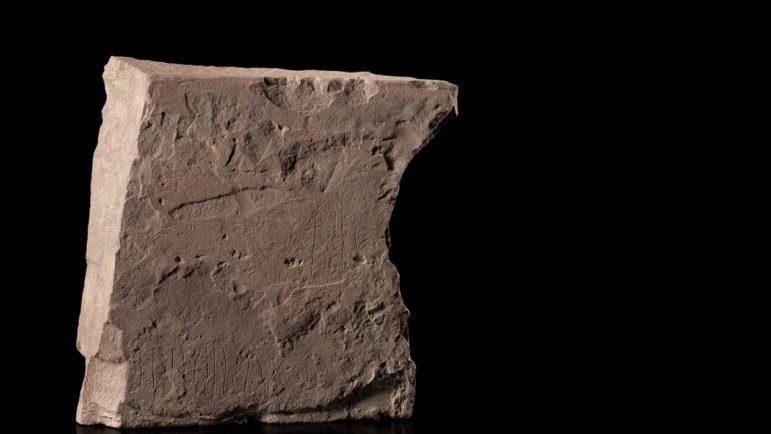OSLO – The Pagan community is well-versed in runes and their presence is almost ubiquitous code for some types of Pagan practice. Runes are used in writing as well as divination in modern practices. Their use is part of faiths such as Heathenry and practices such as Seiðr.
Now archaeologists in Norway have announced that they have found what they believe to be the oldest runestone ever discovered. While older objects with runes have been discovered, including a bone comb with runes found in Denmark, the current find appears to be the oldest on stone.
Researchers at the University of Oslo found the stone in the latter half of 2021 as part of a burial ground excavation in Eastern Norway near the city of Hole, an area well-known for archeological discoveries. The stone was unearthed in a cremation pit that contained burnt bones and charcoal.

The recently discovered Svingerud Stone. Courtesy/Photo Credit: Alexis Pantos/Museum of Cultural History/University of Oslo
The stone was transferred to the Museum of Cultural History in Oslo, which holds Norway’s largest collection of historical artifacts, from the Stone Age to modern times. The museum is part of the university. Researchers said that the stone is “among the oldest runic inscriptions ever found” and “the oldest datable runestone in the world.”
Now named the “Svingerudsteinen,” or “the Svingerud Stone,” the artifact was created some 1,800 to 2,000 years ago by someone near the Tyrifjorden lake located to the west of Oslo. Whoever carved the roughly 12” x 12” (31cm x 32cm) reddish-brown Ringerike sandstone block wrote and, by implication, spoke one of the earliest forms of the Nordic languages of Scandinavia.
“We needed time to analyze and date the runestone,” Dr. Kristel Zilmer, a runologist and professor of Written Culture and Iconography at the University of Oslo, told Norwegian media. The general academic consensus has been that the first runes had been carved on stone between 300 CE and 400 CE. The Svingerudsteinen predates that consensus.
Zilmer said of the discovery that it is “the most sensational thing that I, as an academic, have had” adding that there is still much work to be done on the object.
“Me and my colleagues at the Museum of Cultural History are very excited about this sensational find that makes us rewrite some chapters in the history of runic writing,” Zilmer told CNN.
“It provides first clear evidence of the occurrence of rune-stones in Scandinavia in the first centuries AD, thanks to the possibilities we have had in this case to carry out radiocarbon dating of the grave in which the stone lay,” she added.
“This find will give us a lot of knowledge about the use of runes in the early Iron Age. This may be one of the first attempts to use runes in Norway and Scandinavia on stone,” Kristel Zilmer, a professor at the University of Oslo, of which the museum is a part, told the Associated Press (AP).
As for the text on the Svingerudsteinen, it is still being deciphered. The inscription appears to say “For Idibera,” which may refer to a person, possibly a woman, or perhaps a kin name. But Zilmer noted that there might be other interpretations.
“The stone has several kinds of inscriptions. Some lines form a grid pattern and there are small zigzag figures and other interesting features.” She added, “not all inscriptions have a linguistic meaning. It’s possible that someone has imitated, explored, or played with the writing. Maybe someone was learning how to carve runes.”
Zilmer said: “Having such a runic find fall into our lap is a unique experience and the dream of all runologists. For me, this is a highlight, because it is a unique find that differs from other preserved rune stones.”
Zilmer told AP the discovery was “the most sensational thing that I, as an academic, have had,” saying there was still much more work that could be done to try to understand more about the object. She added, “Without doubt, we will obtain valuable knowledge about the early history of runic writing.”
TWH columnist and expert, Lyonel Perabo considered the find and said, “The fact that this runestone might be older than any other runic artifact calls for a considerable reconsideration of the origins, spread, and significance of the runic script in ancient Europe.” He added, “particularly, the theory that runic writing emerged in the south-Germanic area through contacts with Latinic or Hellenic people might become weakened by the discovery of this particular inscription.”
Perabo noted that the next step is continued research with patience. He said, “this kind of work may take years before coming to fruition so patience will be required. Scholars and Pagans alike will probably be looking closely at any potential traces of ritual practices and deposits, I predict.”
Beginning this Saturday, January 21, the Svingerudsteinen will be exhibited for one month at the Museum of Cultural History in Oslo.
The Wild Hunt is not responsible for links to external content.
To join a conversation on this post:
Visit our The Wild Hunt subreddit! Point your favorite browser to https://www.reddit.com/r/The_Wild_Hunt_News/, then click “JOIN”. Make sure to click the bell, too, to be notified of new articles posted to our subreddit.
